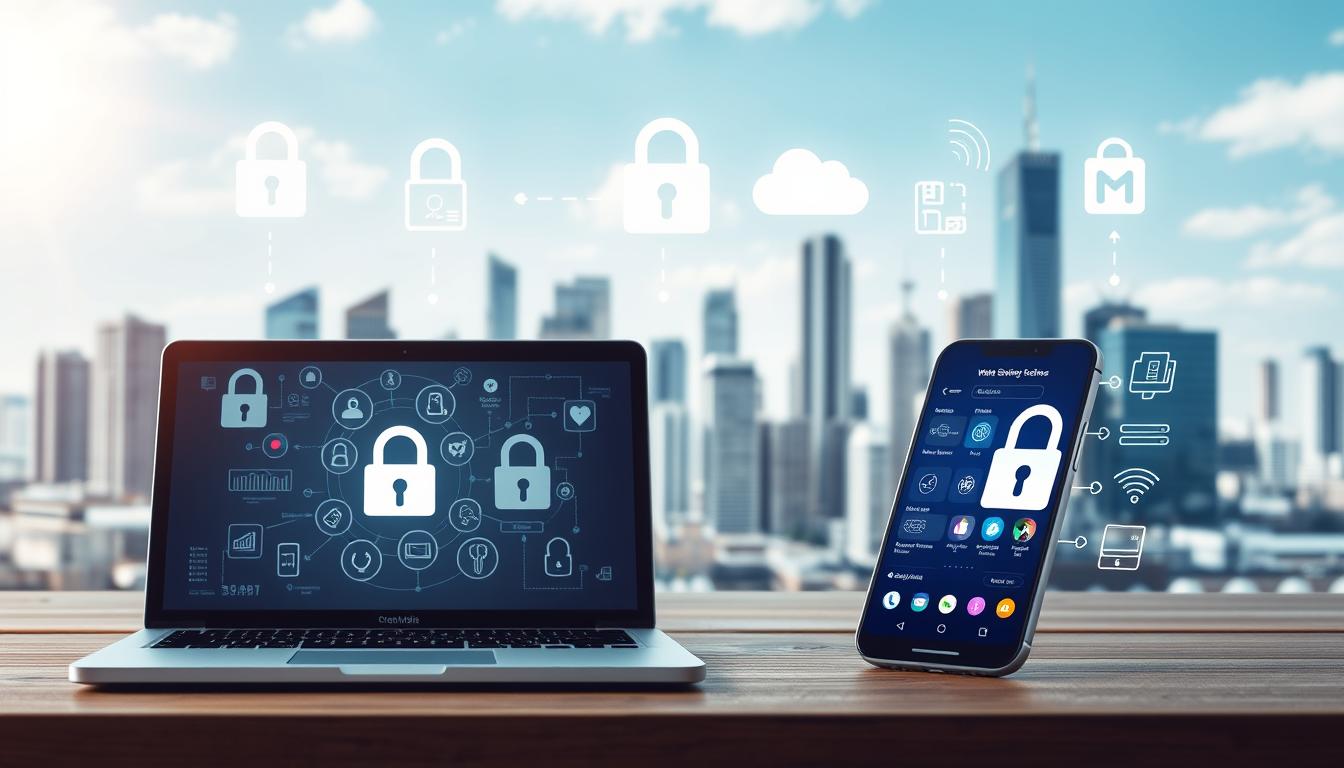In today’s rapidly evolving digital landscape, protecting sensitive information and maintaining robust security measures is paramount. The ever-changing cyber threat landscape necessitates a comprehensive approach to cybersecurity.

Edit
Full screen
Delete
𝗨𝗹𝘁𝗶𝗺𝗮𝘁𝗲 𝗖𝘆𝗯𝗲𝗿𝘀𝗲𝗰𝘂𝗿𝗶𝘁𝘆 𝗧𝗲𝗰𝗵𝗻𝗼𝗹𝗼𝗴𝘆 𝗦𝘁𝗮𝗰k
A well-structured Cybersecurity Tech Stack is crucial for organizations to defend against sophisticated cyber-attacks. This involves integrating various security tools and technologies to create a robust defense system.
By adopting an Ultimate Cybersecurity Technology Stack, businesses can significantly enhance their security posture, ensuring the confidentiality, integrity, and availability of their critical assets.
Key Takeaways
- Understanding the importance of a comprehensive Cybersecurity Tech Stack.
- Recognizing the need for a robust cybersecurity approach.
- Identifying key components of an effective Cybersecurity Technology Stack.
- Enhancing security posture through integrated security tools.
- Protecting critical assets from evolving cyber threats.
The Growing Importance of Comprehensive Cybersecurity
In today’s digital landscape, comprehensive cybersecurity is no longer a luxury, but a necessity for businesses worldwide. As technology continues to advance and cyber threats become more sophisticated, the need for robust cybersecurity measures has never been more critical.
Current Threat Landscape Statistics
The current threat landscape is alarming, with cyber attacks increasing by 38% in 2022 alone, according to recent studies. The average cost of a cyber attack is now estimated to be around $4.35 million, highlighting the significant financial risk businesses face if they fail to implement adequate cybersecurity solutions.
The Cost of Security Breaches for Businesses
The financial impact of security breaches extends beyond immediate costs, affecting businesses through lost productivity, damaged reputation, and potential legal liabilities.
“The average cost of a data breach is $4.45 million, with companies facing significant long-term consequences.”
Investing in comprehensivecybersecurity solutionsis crucial to mitigate these risks and protect against the ever-evolving landscape ofcyber threats.
Understanding the Ultimate Cybersecurity Technology Stack
As cyber threats become increasingly sophisticated, understanding the components of an ultimate cybersecurity technology stack is vital. This stack is not just a collection of tools; it’s a comprehensive framework designed to protect an organization’s digital assets from various angles.
Definition and Core Components
The ultimate cybersecurity technology stack refers to a layered set of security solutions designed to protect an organization’s infrastructure, applications, and data. The core components typically include network security, endpoint security, cloud security, and data protection tools.
| Component | Description |
| Network Security | Protects the network infrastructure from unauthorized access and attacks. |
| Endpoint Security | Secures endpoint devices such as laptops, desktops, and mobile devices. |
| Cloud Security | Safeguards cloud-based services and data. |
The Layered Security Approach
Adopting a layered security approach is fundamental to a robust cybersecurity strategy. This involves implementing multiple security controls at different layers, making it harder for attackers to penetrate. As security expert Bruce Schneier once said,
“Defense in depth is a simple concept: instead of one defensive mechanism, you have several, layered.”
By understanding and implementing the ultimate cybersecurity technology stack with a layered security approach, organizations can significantly enhance their cybersecurity posture.
Network Security Layer: Essential Tools and Technologies
A robust network security layer is essential for safeguarding an organization’s network infrastructure. This layer comprises various tools and technologies that work together to protect against cyber threats. In this section, we will explore the key components of the network security layer.
Next-Generation Firewalls
Next-Generation Firewalls (NGFWs) are a crucial element of network security. They provide advanced threat detection capabilities, including deep packet inspection and application awareness. NGFWs can identify and block sophisticated threats, such as malware and intrusion attempts. For instance, Palo Alto Networks offers a leading NGFW solution that integrates with various security tools to enhance threat detection.
Intrusion Detection and Prevention Systems
Intrusion Detection and Prevention Systems (IDPS) monitor network traffic for signs of unauthorized access or malicious activity. These systems can detect and prevent intrusions, helping to protect against data breaches and other security incidents. Snort, an open-source IDPS, is widely used for its effectiveness in detecting threats.
Network Access Control Solutions
Network Access Control (NAC) solutions enforce policy on devices that access network resources. NAC systems ensure that only authorized devices and users can access the network, reducing the risk of insider threats. They can also enforce compliance with security policies, such as requiring up-to-date antivirus software. A notable NAC solution is provided by Cisco, which offers comprehensive access control features.
| Security Tool | Function | Example |
| Next-Generation Firewalls | Advanced threat detection and prevention | Palo Alto Networks |
| Intrusion Detection and Prevention Systems | Monitoring and prevention of intrusions | Snort |
| Network Access Control Solutions | Enforcing access policies | Cisco |
Endpoint Security: Protecting All Connected Devices
As the number of connected devices continues to grow, protecting these endpoints from cyber threats is more important than ever. Endpoint security encompasses a range of technologies and practices designed to safeguard devices such as laptops, desktops, mobile devices, and servers from malicious attacks.
Advanced Endpoint Protection Platforms
Advanced Endpoint Protection Platforms (AEPPs) represent a significant evolution in endpoint security. Unlike traditional antivirus solutions, AEPPs use machine learning and behavioral analysis to detect and prevent sophisticated threats. Key features of AEPPs include real-time threat detection, automated response capabilities, and comprehensive visibility across all endpoints.
| Feature | Description | Benefit |
| Real-time Threat Detection | Identifies and responds to threats as they occur | Reduces risk of data breaches |
| Automated Response | Automatically isolates or remediates threats | Minimizes manual intervention |
| Comprehensive Visibility | Provides detailed insights into endpoint activities | Enhances security posture |
Mobile Device Management Solutions
Mobile Device Management (MDM) solutions are crucial for organizations with a mobile workforce. MDM solutions enable IT teams to manage, secure, and monitor mobile devices across the enterprise. Key capabilities include device enrollment, policy enforcement, and remote wipe capabilities, ensuring that corporate data remains secure even on personal devices.
Edit
Delete
IoT Security Considerations
The Internet of Things (IoT) introduces a vast number of new endpoints that must be secured. IoT security considerations include device authentication, data encryption, and regular firmware updates. Organizations must also be aware of the potential vulnerabilities introduced by IoT devices and implement strategies to mitigate these risks.
By implementing robust endpoint security measures, including advanced endpoint protection platforms, mobile device management solutions, and IoT security considerations, organizations can significantly reduce their risk exposure to cyber threats.
Cloud Security: Safeguarding Your Digital Assets
As organizations increasingly migrate to cloud environments, securing these digital ecosystems becomes paramount. The cloud offers numerous benefits, including scalability, flexibility, and cost-efficiency, but it also introduces new security challenges that must be addressed to protect sensitive data and applications.
Cloud Access Security Brokers (CASB)
Cloud Access Security Brokers (CASB) are critical components of cloud security infrastructure. They act as intermediaries between users and cloud service providers, enforcing security policies and protecting data. CASB solutions offer visibility into cloud usage, data protection through encryption and tokenization, and threat detection. By implementing a CASB, organizations can ensure compliance with regulatory requirements and safeguard against data breaches.
Cloud Workload Protection Platforms
Cloud Workload Protection Platforms (CWPP) are designed to secure workloads in cloud environments. These platforms provide comprehensive security for virtual machines, containers, and serverless functions. CWPP solutions offer features such as vulnerability assessment, malware detection, and runtime protection. By leveraging CWPP, organizations can ensure the integrity and security of their cloud workloads, reducing the risk of cyber threats.
Secure Cloud Configuration Tools
Secure Cloud Configuration Tools are essential for maintaining the security and compliance of cloud environments. These tools help organizations manage and monitor their cloud configurations, ensuring that resources are properly set up and secured. They provide automated checks for misconfigurations, compliance monitoring, and remediation capabilities. By utilizing Secure Cloud Configuration Tools, organizations can prevent security risks associated with misconfigured cloud resources and maintain a strong security posture.
Data Protection and Privacy Tools
As data breaches continue to rise, the importance of robust data protection and privacy tools cannot be overstated. Organizations must implement comprehensive strategies to safeguard sensitive information and comply with increasingly stringent privacy regulations.
Data Loss Prevention Solutions
Data Loss Prevention (DLP) solutions are critical for identifying, monitoring, and protecting sensitive data. These tools help organizations prevent data breaches by detecting and blocking unauthorized data transfers. Key features of DLP solutions include:
- Content inspection and classification
- Real-time monitoring and alerting
- Policy enforcement across endpoints, networks, and cloud services
By implementing DLP solutions, businesses can significantly reduce the risk of data leaks and ensure compliance with data protection regulations.
Encryption Technologies
Encryption is a fundamental component of data protection, rendering sensitive information unreadable to unauthorized parties. Modern encryption technologies include:
- Symmetric encryption: Fast and efficient, used for large data sets.
- Asymmetric encryption: Provides secure key exchange and authentication.
- Homomorphic encryption: Allows computations on encrypted data.
By leveraging these encryption technologies, organizations can protect data both at rest and in transit, ensuring confidentiality and integrity.

Edit
Full screen
Delete
Data Protection and Privacy Tools
Privacy Compliance Tools
Privacy compliance tools help organizations navigate the complex landscape of data privacy regulations, such as GDPR and CCPA. These tools offer features like:
- Data subject access request management
- Consent management and tracking
- Data minimization and retention policies
By utilizing privacy compliance tools, businesses can streamline their compliance efforts, reduce the risk of regulatory fines, and build trust with their customers.
Identity and Access Management Solutions
As cyber threats evolve, Identity and Access Management Solutions have become indispensable for protecting sensitive information and systems. These solutions enable organizations to manage digital identities and control user access to critical resources effectively.
Multi-Factor Authentication Systems
Multi-Factor Authentication (MFA) adds an extra layer of security by requiring users to provide two or more verification factors to gain access to a resource. This significantly reduces the risk of unauthorized access due to compromised credentials. MFA can include something you know (password), something you have (token or smartphone), or something you are (biometric data).
Privileged Access Management
Privileged Access Management (PAM) involves managing and securing access for privileged users or accounts that have elevated permissions within an organization. PAM solutions help prevent unauthorized access and potential breaches by controlling and monitoring privileged accounts.
Single Sign-On Solutions
Single Sign-On (SSO) allows users to access multiple applications or systems with a single set of login credentials, enhancing user experience while maintaining security. SSO simplifies access management and reduces the complexity associated with multiple usernames and passwords.
Zero Trust Architecture Implementation
Implementing a Zero Trust Architecture involves verifying the identity and permissions of users and devices before granting access to resources, assuming that threats could be internal or external. This approach enhances security by minimizing the attack surface and ensuring that access is granted on a need-to-know basis.
| IAM Component | Functionality | Security Benefit |
| Multi-Factor Authentication | Requires multiple verification factors | Reduces unauthorized access risk |
| Privileged Access Management | Manages and secures privileged accounts | Prevents breaches from privileged accounts |
| Single Sign-On | Simplifies access with single credentials | Enhances user experience and security |
Security Operations and Incident Response
With the rise in sophisticated cyberattacks, having a solid security operations and incident response plan is essential. Security operations encompass the processes and technologies used to monitor, detect, and respond to security incidents. Incident response refers to the coordinated effort to handle the consequences of a security breach or cyberattack.

Edit
Full screen
Delete
Security Operations and Incident Response
Security Information and Event Management (SIEM)
SIEM systems are critical for collecting and analyzing log data from various sources across the IT infrastructure. They help in identifying potential security threats by correlating events and providing real-time analysis. Effective SIEM solutions enable organizations to detect anomalies and respond to incidents promptly.
Security Orchestration, Automation and Response (SOAR)
SOAR solutions streamline security operations by automating incident response processes and integrating various security tools. They help in reducing the time taken to respond to security incidents and improve the overall efficiency of the security team. By automating routine tasks, SOAR enables security professionals to focus on more complex threats.
Digital Forensics Tools
Digital forensics tools are used to investigate security incidents by analyzing data from compromised systems. These tools help in identifying the root cause of an incident, understanding the attack vector, and gathering evidence for potential legal proceedings. Advanced digital forensics tools can analyze large volumes of data and provide insights into complex cybercrimes.
Threat Intelligence Platforms
Threat intelligence platforms play a crucial role in enhancing security operations by providing insights into emerging threats. They aggregate data from various sources to provide a comprehensive view of the threat landscape. By leveraging threat intelligence, organizations can proactively strengthen their defenses and improve incident response strategies.
Emerging Technologies Shaping the Future of Cybersecurity
Emerging technologies are transforming the cybersecurity landscape, offering new tools and methodologies to combat evolving threats. As we move forward, it’s crucial to understand how these technologies are being leveraged to enhance cybersecurity.
Artificial Intelligence and Machine Learning in Security
Artificial Intelligence (AI) and Machine Learning (ML) are revolutionizing cybersecurity by providing advanced threat detection and response capabilities. These technologies enable systems to learn from data, identify patterns, and predict potential threats.
Blockchain for Cybersecurity
Blockchain technology is being explored for its potential to enhance cybersecurity through secure data storage and transaction verification. Its decentralized nature makes it difficult for hackers to manipulate data.
Quantum Computing Security Implications
Quantum computing has the potential to significantly impact cybersecurity, both positively and negatively. Organizations must prepare for a post-quantum world by developing quantum-resistant cryptographic techniques.
| Emerging Technology | Cybersecurity Application |
| Artificial Intelligence | Advanced threat detection and response |
| Blockchain | Secure data storage and identity verification |
| Quantum Computing | Potential for both breaking and enhancing encryption methods |
The integration of these emerging technologies into cybersecurity strategies is crucial for staying ahead of evolving threats.
Conclusion: Building and Maintaining Your Cybersecurity Posture
Building a robust cybersecurity posture is crucial in today’s evolving threat landscape. As discussed, a comprehensive cybersecurity tech stack is essential for protecting against cyber threats. This involves implementing a layered security approach that includes network security, endpoint protection, cloud security, data protection, and identity and access management.
Maintaining cybersecurity requires continuous monitoring and updates to stay ahead of emerging threats. By leveraging technologies such as artificial intelligence, machine learning, and blockchain, organizations can enhance their cybersecurity capabilities. Regular security assessments and incident response planning are also vital components of a strong cybersecurity posture.
A well-designed cybersecurity tech stack enables organizations to respond effectively to security incidents and minimize potential damage. By prioritizing building and maintaining cybersecurity, businesses can safeguard their digital assets and maintain customer trust.
FAQ
What is a cybersecurity tech stack?
A cybersecurity tech stack refers to the collection of tools, technologies, and solutions used to protect an organization’s digital assets from cyber threats.
Why is a comprehensive cybersecurity approach necessary?
A comprehensive cybersecurity approach is necessary due to the ever-evolving cyber threat landscape, which requires a robust and layered security strategy to protect against various types of threats.
What are the core components of the ultimate cybersecurity technology stack?
The core components include network security, endpoint security, cloud security, data protection and privacy tools, identity and access management solutions, and security operations and incident response.
How do next-generation firewalls contribute to network security?
Next-generation firewalls provide advanced threat detection and prevention capabilities, including deep packet inspection and application awareness, to protect network infrastructure.
What is the role of encryption technologies in data protection?
Encryption technologies play a crucial role in protecting sensitive data by converting it into an unreadable format, making it inaccessible to unauthorized parties.
How does multi-factor authentication enhance security?
Multi-factor authentication enhances security by requiring users to provide multiple forms of verification, making it more difficult for attackers to gain unauthorized access to resources.
What are the benefits of implementing a zero trust architecture?
Implementing a zero trust architecture provides benefits such as improved security posture, reduced risk of data breaches, and enhanced visibility and control over user access.
How do security information and event management (SIEM) systems contribute to security operations?
SIEM systems provide real-time monitoring and analysis of security-related data, enabling organizations to detect and respond to security incidents more effectively.
What is the impact of artificial intelligence and machine learning on cybersecurity?
Artificial intelligence and machine learning are being used to enhance cybersecurity by improving threat detection, incident response, and predictive analytics, enabling organizations to stay ahead of emerging threats.
How can organizations maintain a robust cybersecurity posture?
Organizations can maintain a robust cybersecurity posture by regularly reviewing and updating their cybersecurity tech stack, staying informed about emerging threats, and investing in ongoing training and education for their security teams.

